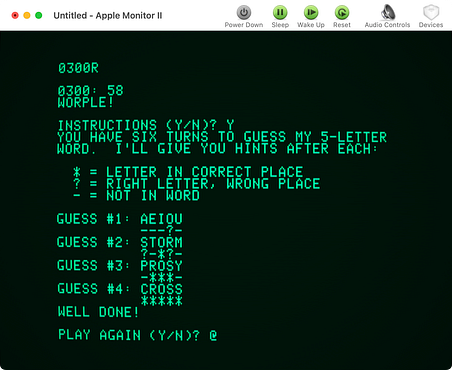New Antique Game Options
Happening on an “Apple news site” post a little while ago about how to emulate the original Apple I single-board computer using a system-specific program I’ve had installed for some time was a bit of a surprise. I did get to thinking, though, how having already tried out OpenEmulator’s emulation of that computer did add something to an awareness of certain dark comments about the survivors (who in this case haven’t played by “hacker rules” for years) having written the history books and the Apple I not being all that useful regardless of the lovable “Woz” having designed it. It could, I suppose, do a bit more than an Altair 8800 with no expansion cards (I gather the earlier computer in that unenhanced state couldn’t do much more than blink its panel lights and produce RFI interference capable of evoking musical static from nearby AM radios), but rather less than an Altair or other “S-100 bus” machine well equipped. When I got to the point where the article mentioned how to get an Apple I version of Wordle running, though, my interest picked up and I resolved to start up that particular option in OpenEmulator once more.
Squashing Wordle into four kilobytes of RAM did mean a lot of sacrifices. Not only did it not bother to check for genuine words such that I could just “test every vowel” to start with, I had to keep track myself of what letters had already been eliminated. That made it a bit less engaging than even the RAM-constrained version of Wordle for the TRS-80 Model 100, which I’ve been able to run on actual hardware even if I’ve seen one or two Apple I boards in museums.
In thinking about those museum pieces I did look up the Apple I registry, and there I happened to check out the “software” section to notice “2048” and the “15 puzzle” have also been ported to the computer. 2048 is rather simplistic even if rather easier than Threes, and this version of the 15 puzzle required thinking in terms of “moving the empty space” rather than “moving a number into the empty space.” They still meant just a little more can be done with this small starting point in history without programming it yourself.

Squashing Wordle into four kilobytes of RAM did mean a lot of sacrifices. Not only did it not bother to check for genuine words such that I could just “test every vowel” to start with, I had to keep track myself of what letters had already been eliminated. That made it a bit less engaging than even the RAM-constrained version of Wordle for the TRS-80 Model 100, which I’ve been able to run on actual hardware even if I’ve seen one or two Apple I boards in museums.
In thinking about those museum pieces I did look up the Apple I registry, and there I happened to check out the “software” section to notice “2048” and the “15 puzzle” have also been ported to the computer. 2048 is rather simplistic even if rather easier than Threes, and this version of the 15 puzzle required thinking in terms of “moving the empty space” rather than “moving a number into the empty space.” They still meant just a little more can be done with this small starting point in history without programming it yourself.

